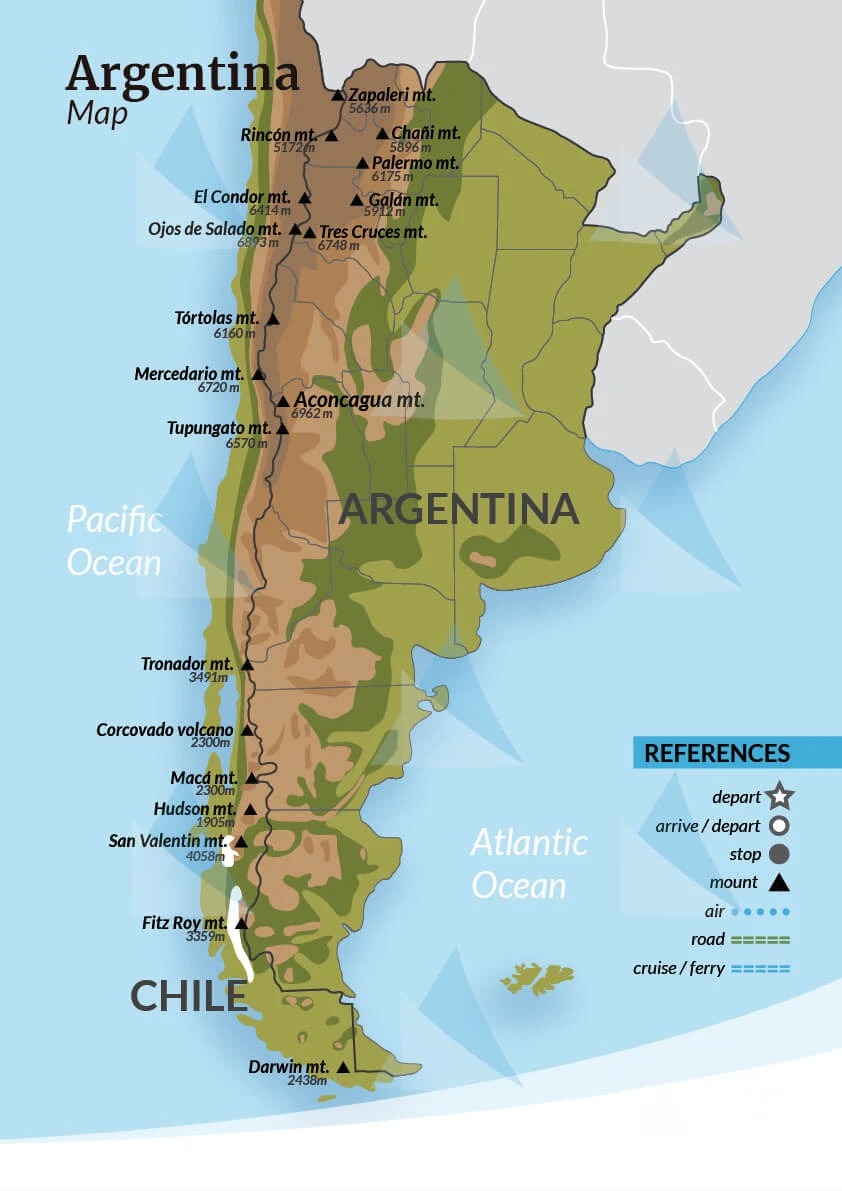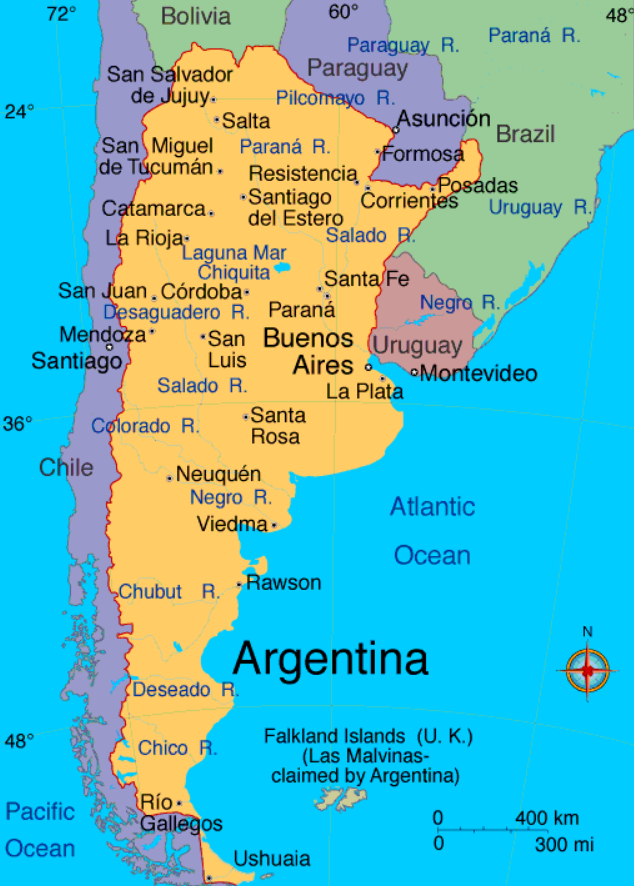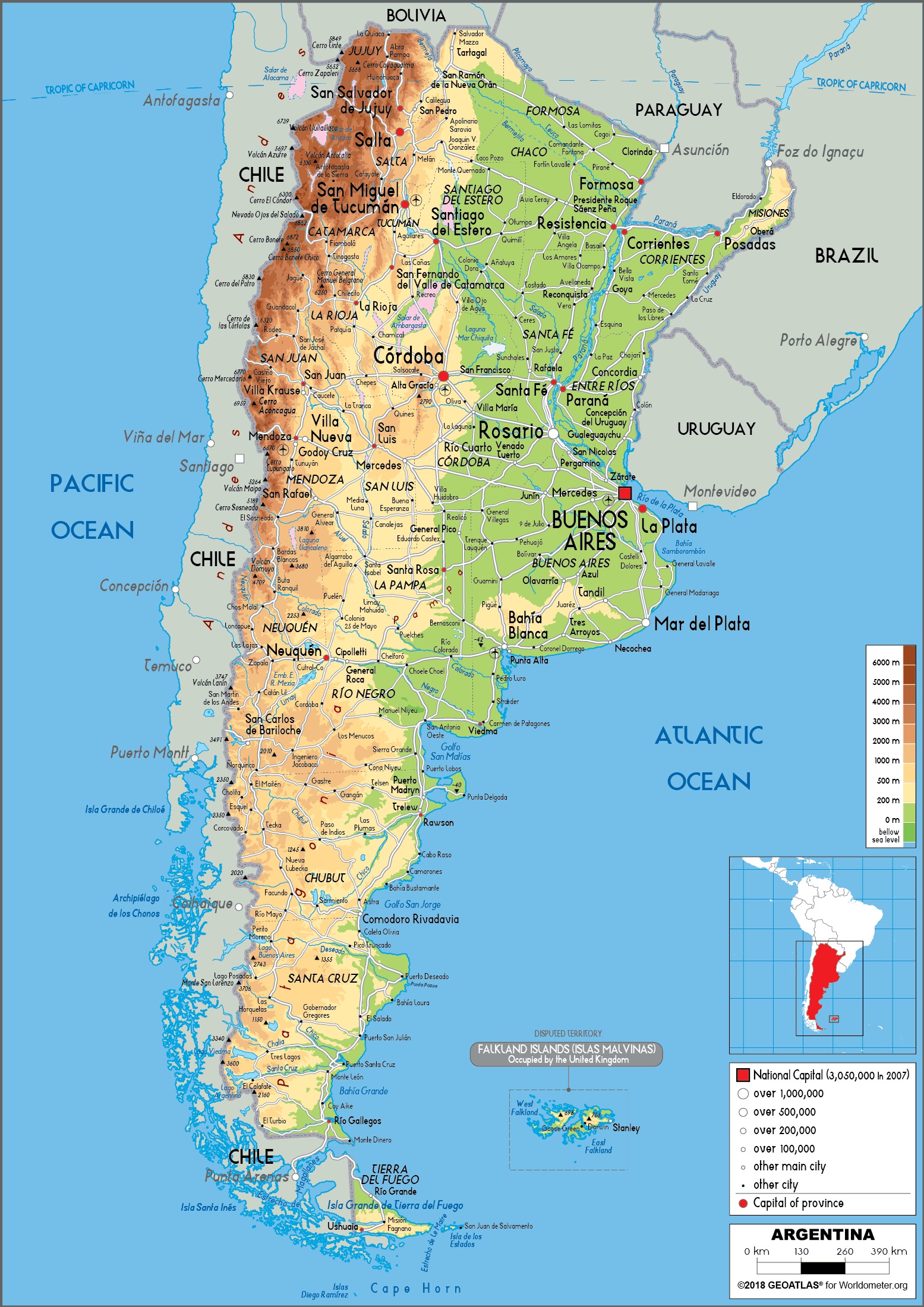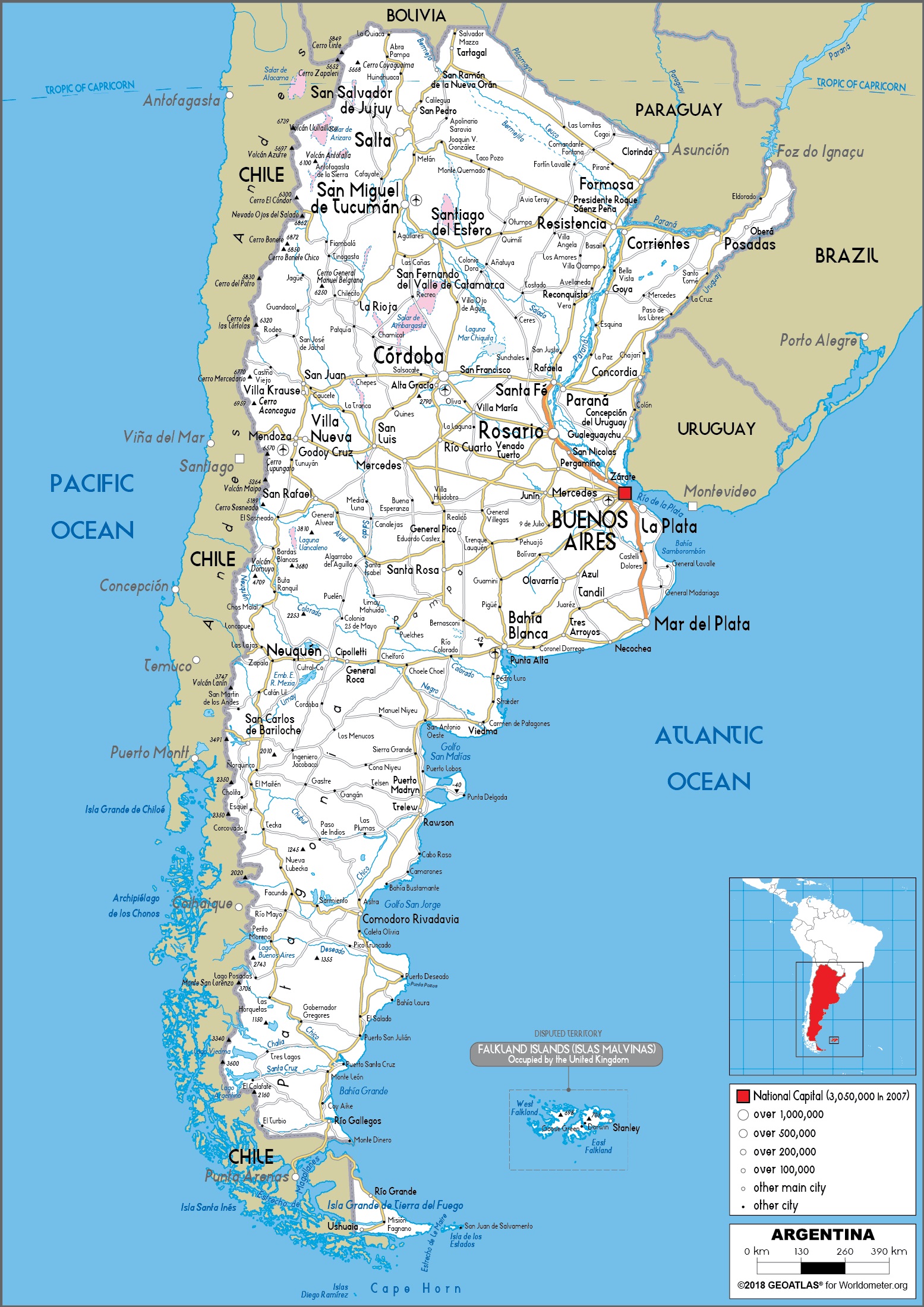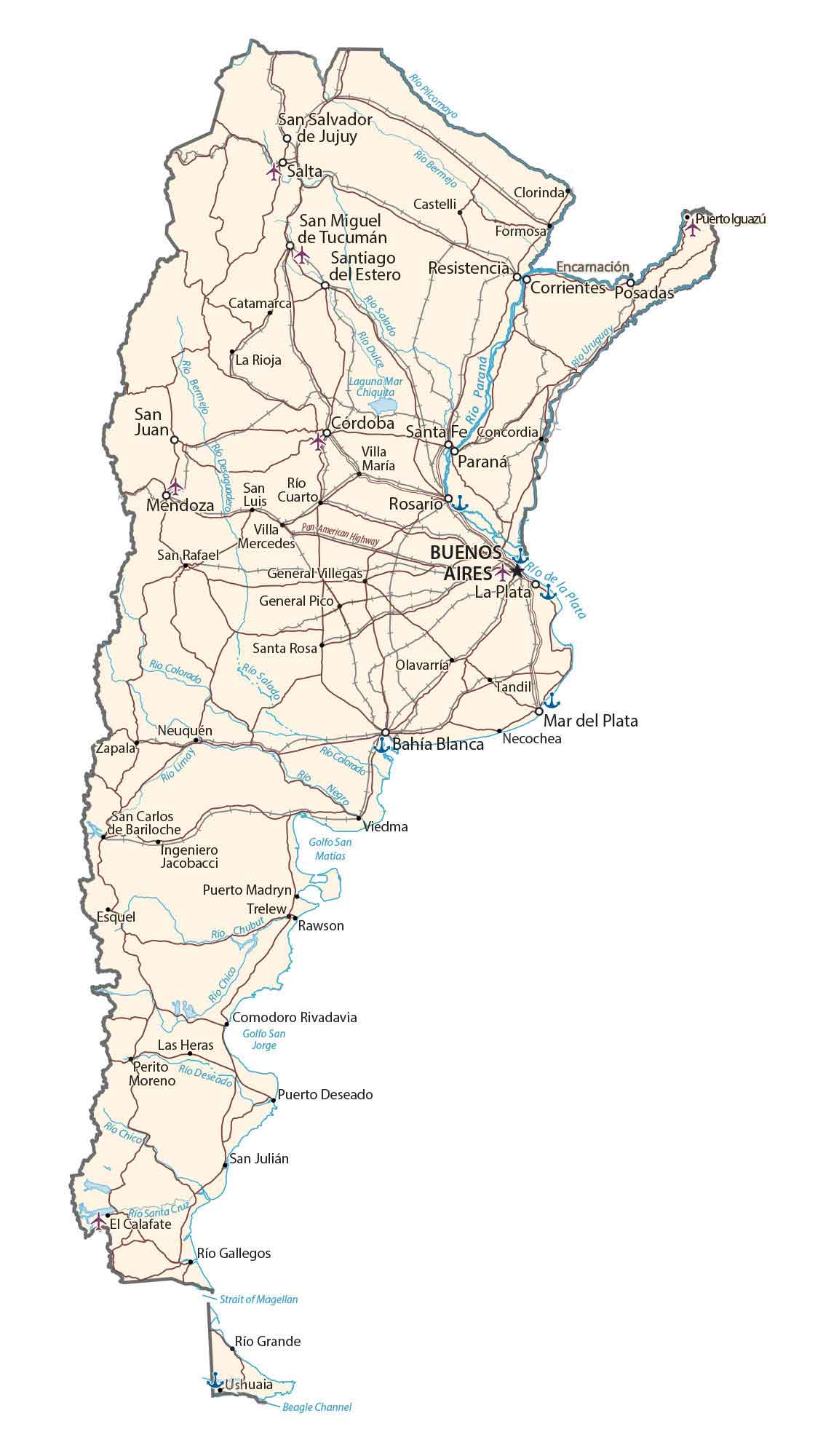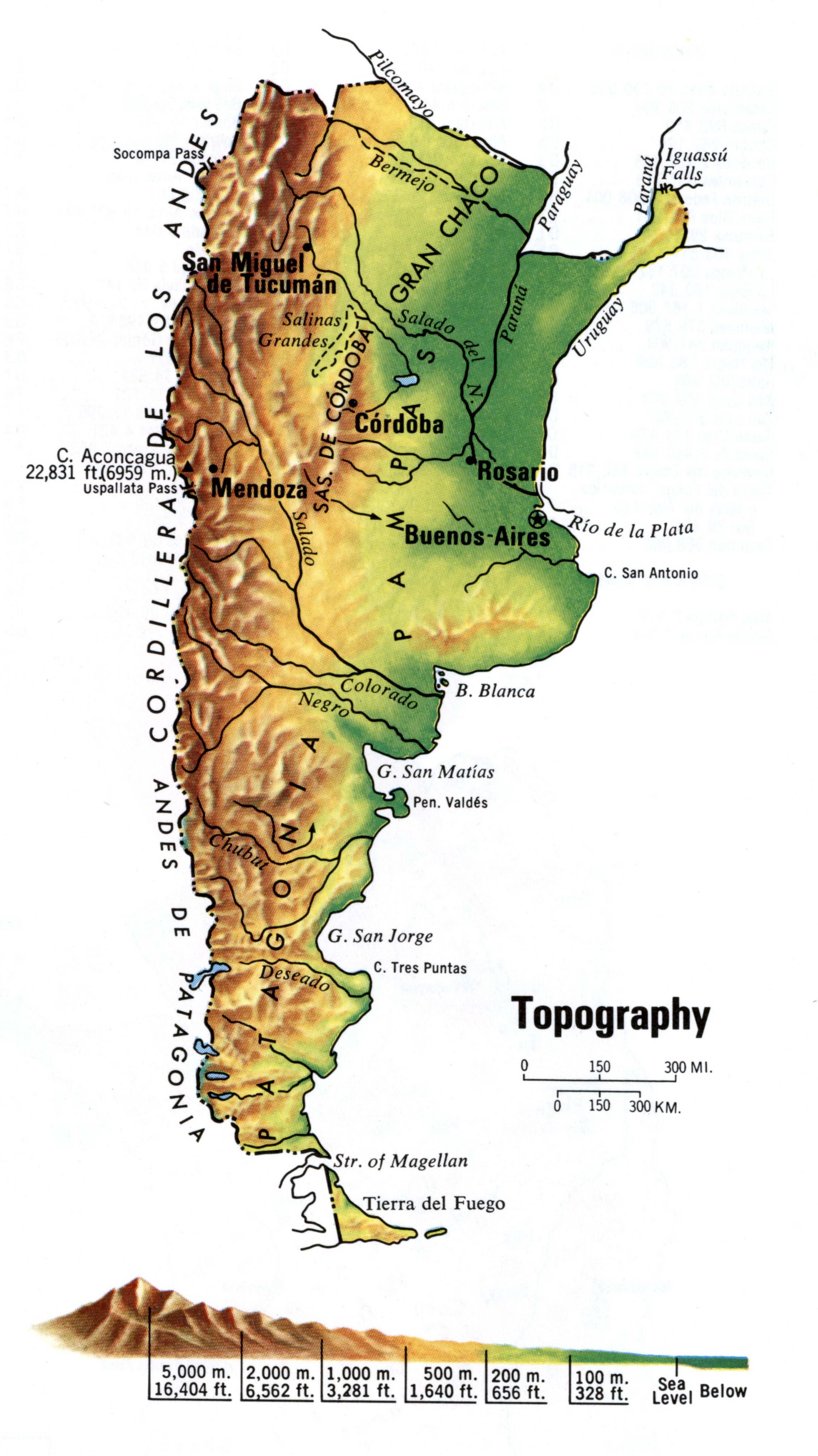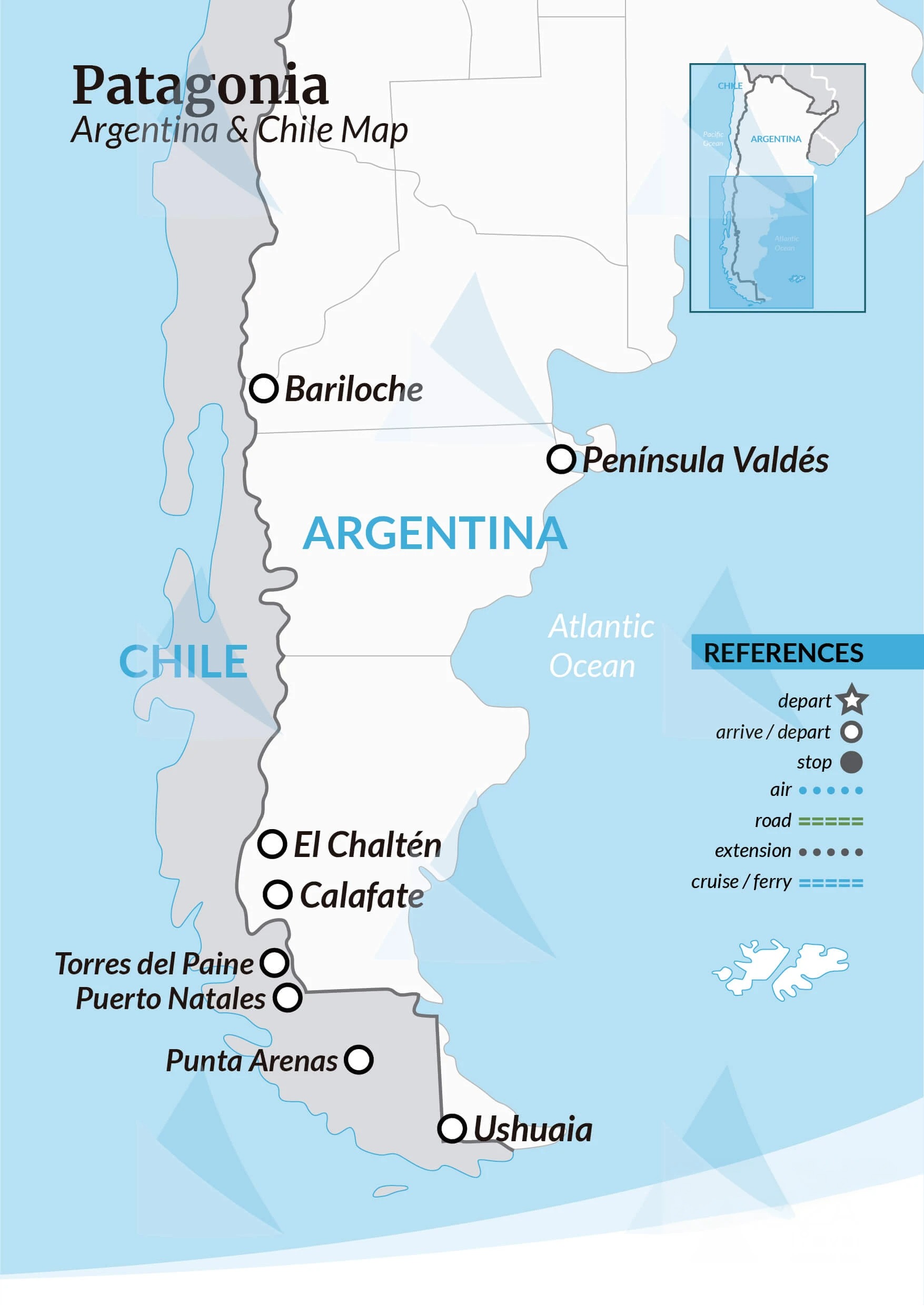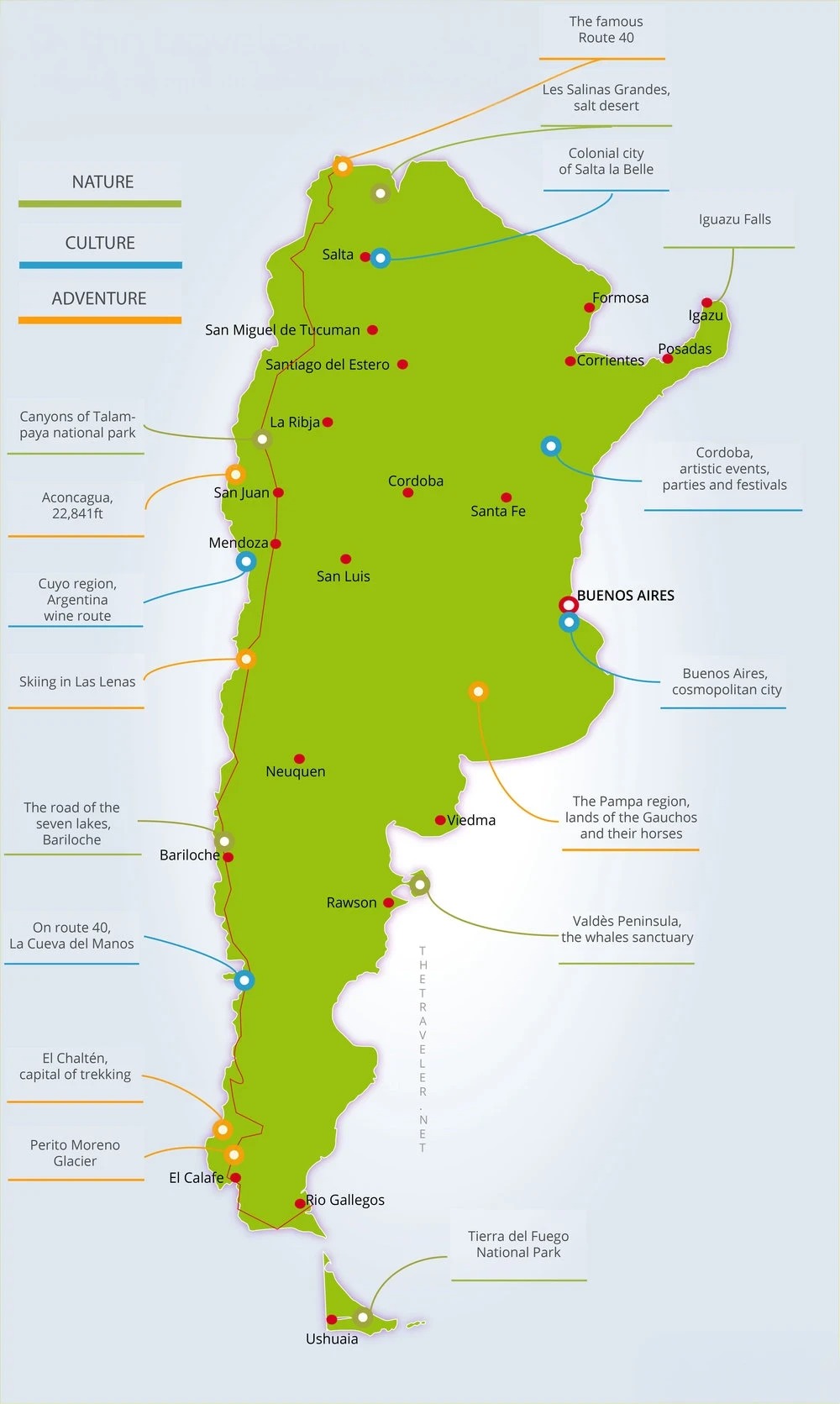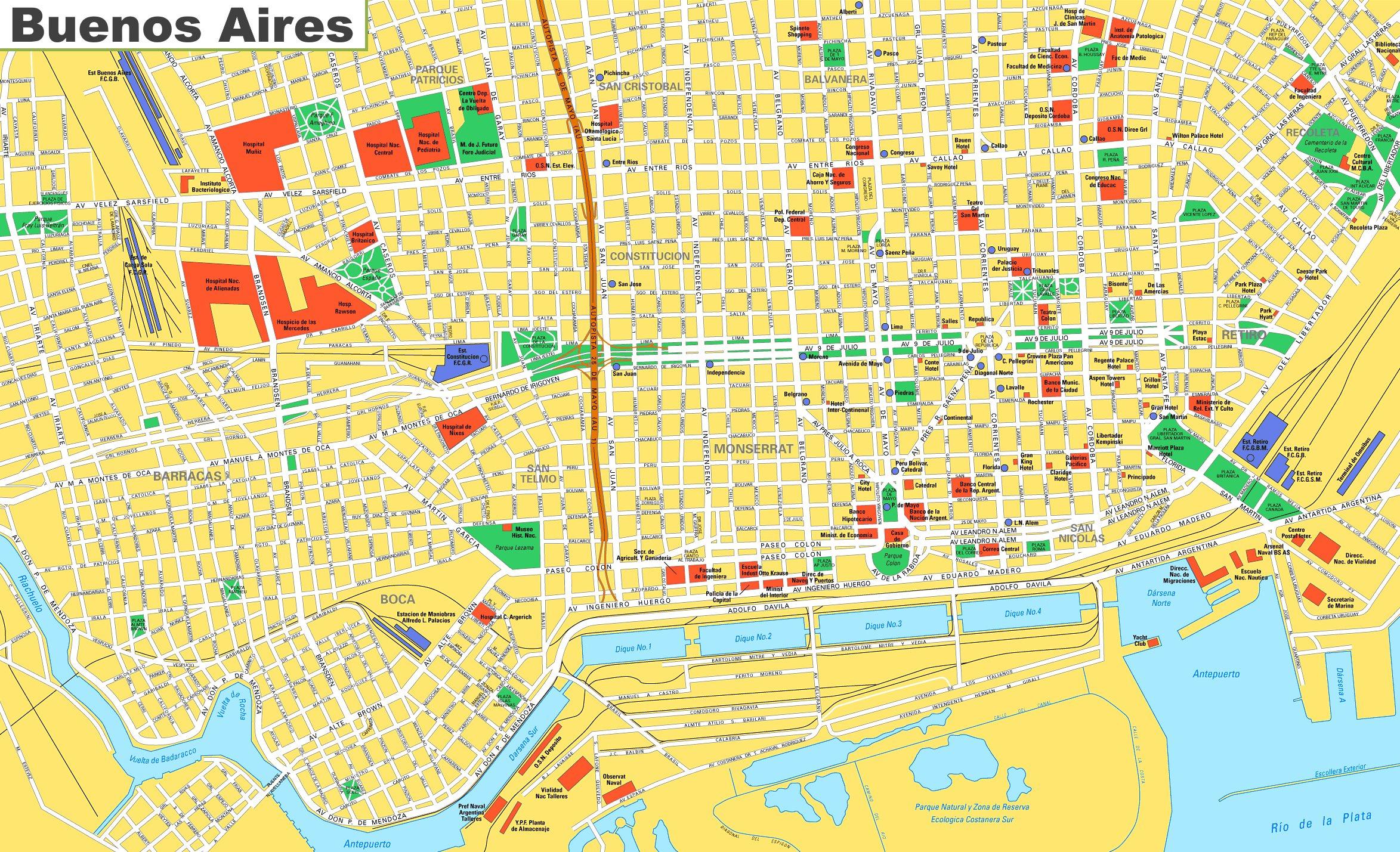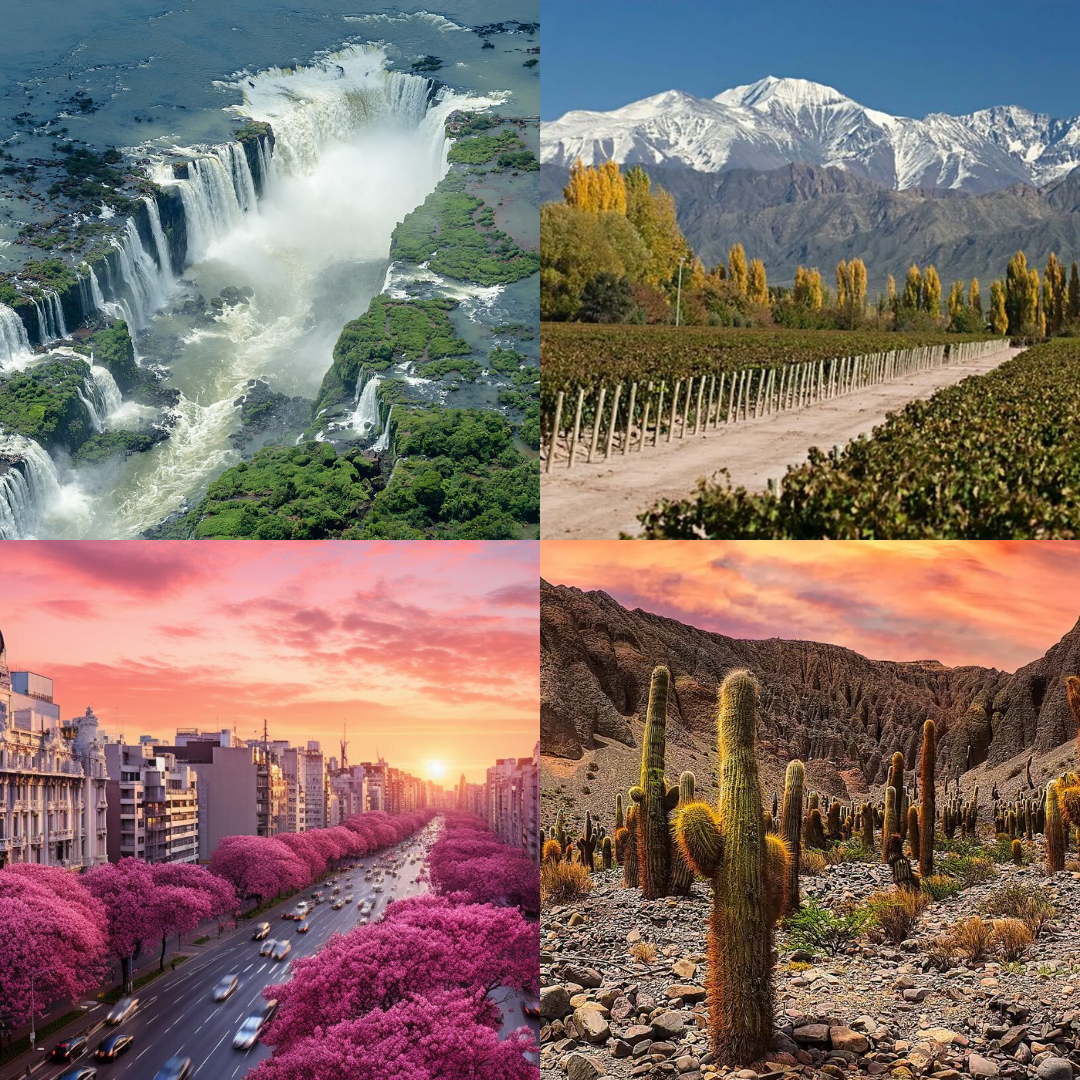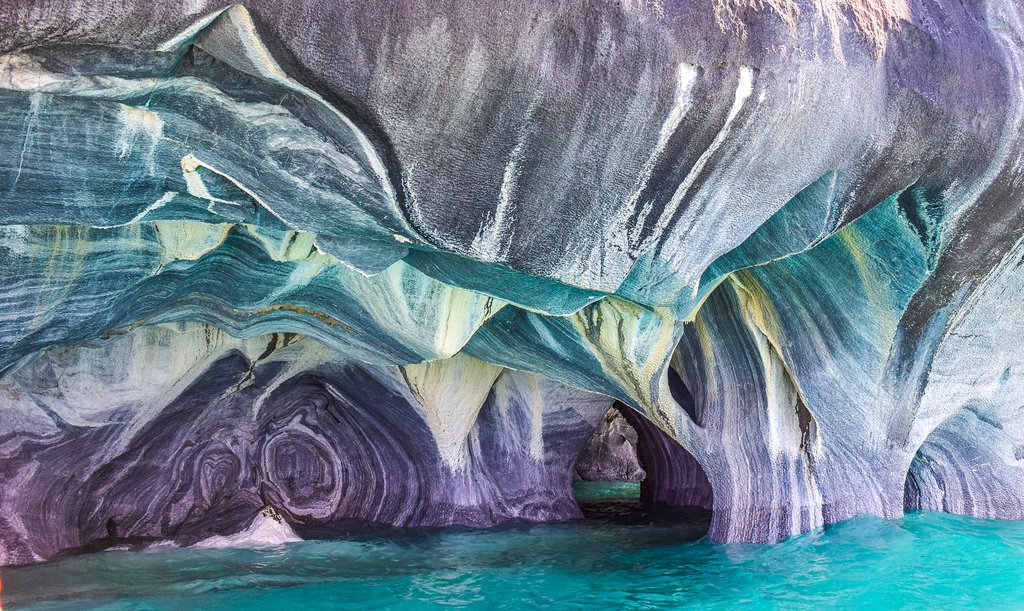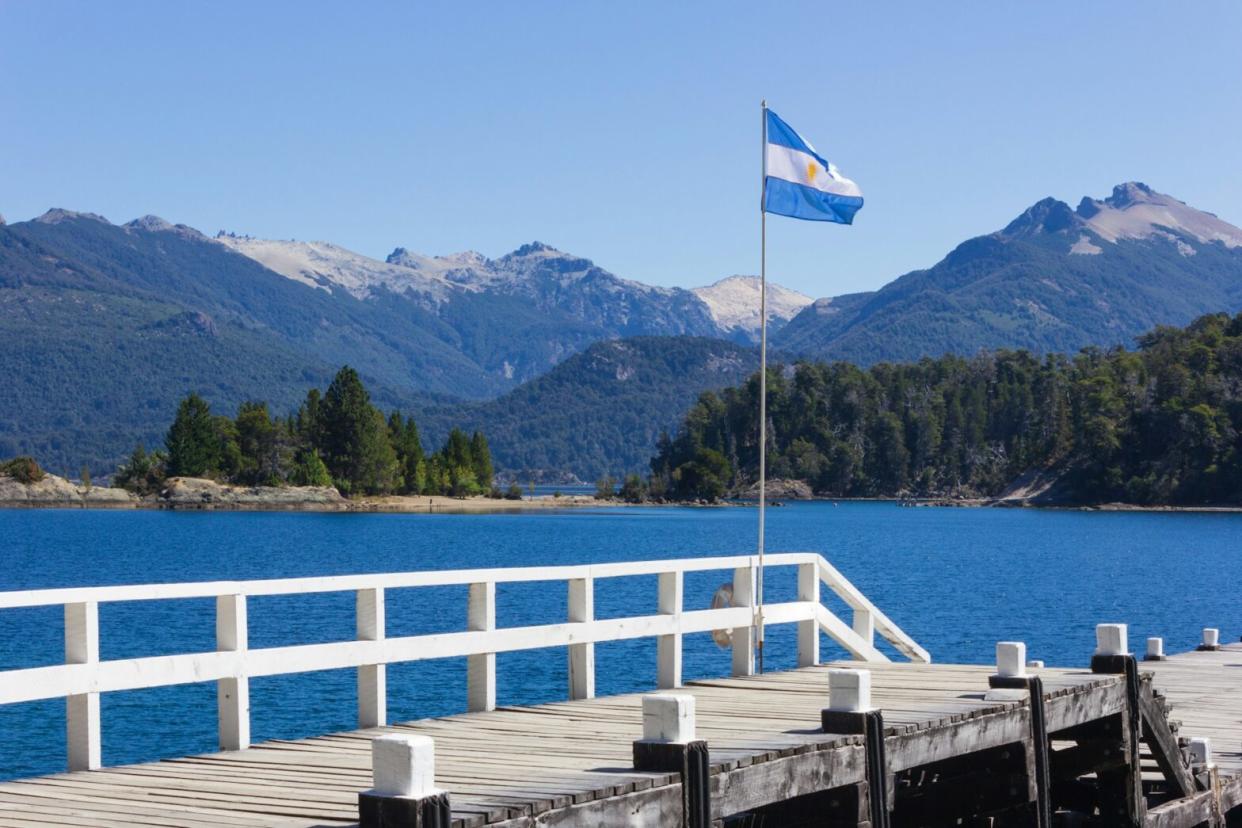Argentina Map - Cities, Roads, Attractions, And More
Argentina maps made simple! Discover political, physical, and tourist maps for planning trips, exploring regions, and uncovering hidden gems.
Author:Finn WildeReviewer:Michael RachalFeb 18, 202519.4K Shares380.7K Views
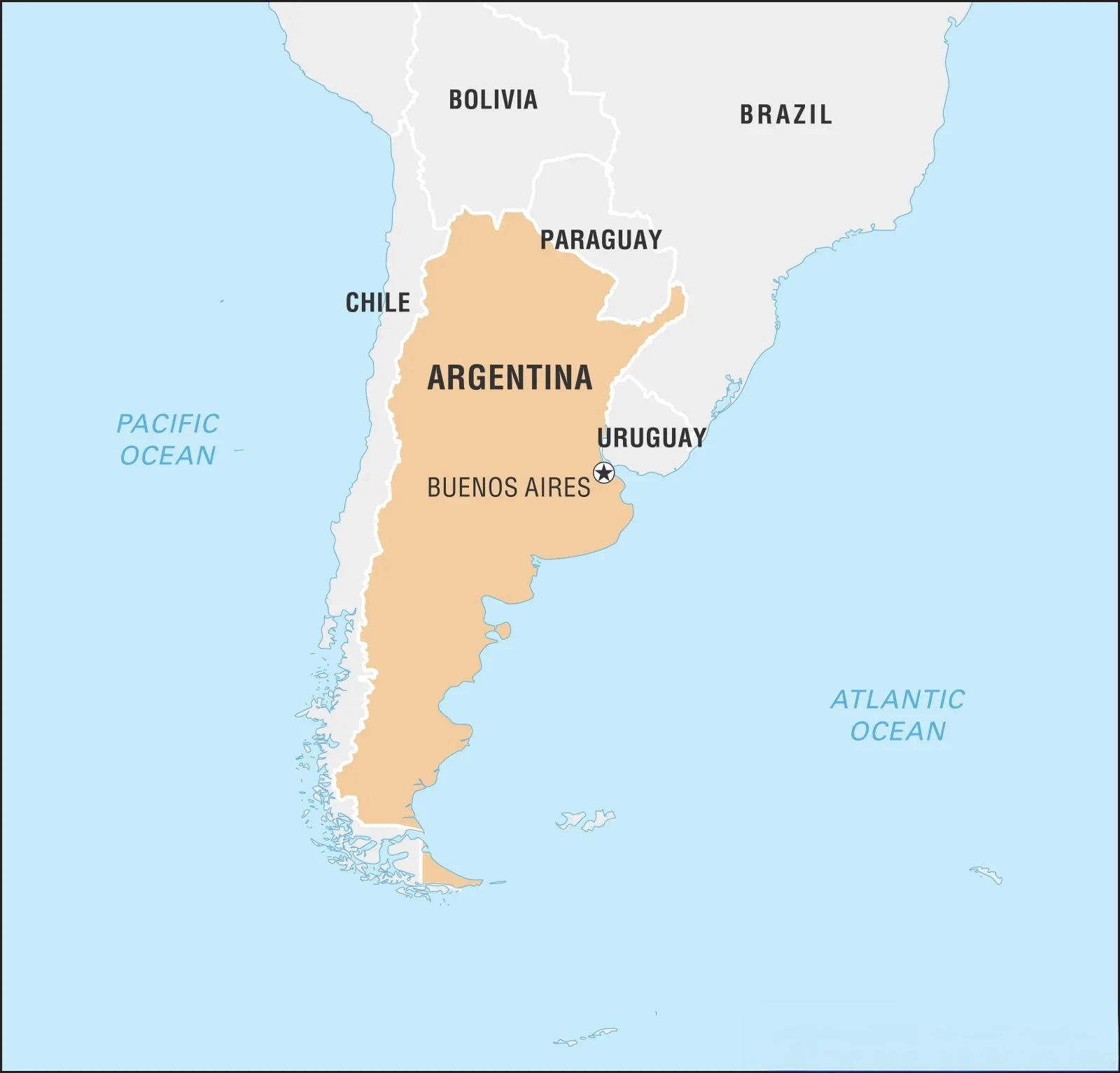
Argentina is a land of stunning diversity, offering everything from towering Andean peaks to the vast Pampas plains and rugged Patagonian landscapes. As the eighth-largest country in the world and the second-largest in South America, Argentina's geography and culture captivate travelers and geographers alike.
This guide looks at Argentina's maps, from political to physical, as well as its fascinating facts and must-see attractions.
Quick Facts About Argentina
| Fact | Detail |
| Population | 46.65 million (2023) |
| Area | 2.78 million km² |
| Capital | Buenos Aires |
| Official Language | Spanish |
| Currency | Argentine Peso (ARS) |
| Dialing Code | +54 |
| Time Zone | UTC -3 |
| Flag Description | Horizontal triband: light blue, white, light blue with a golden sun in the center. |
Geographical Overview
Argentina, a sprawling nation occupying a significant portion of South America's southern cone, boasts a remarkable diversity of landscapes. From the soaring peaks of the Andes to the vast, fertile plains of the Pampas, the country offers a breathtaking array of geographical wonders.
Regional Divisions:
Northwest:This region is dominated by the majestic Andes Mountains, home to Aconcagua, the highest peak in the Americas. The fertile valleys of the Northwest support thriving agriculture, with sugarcane, tobacco, and citrus fruits being major crops.
Northeast:The lush and humid landscapes of the Gran Chaco characterize this region. While rich in biodiversity, the Gran Chaco faces significant environmental challenges, primarily deforestation, which has become a pressing concern in recent years.
Center:The heart of Argentina lies in the Pampas, an expansive plain renowned for its fertile soil. This region is the breadbasket of the nation, producing vast quantities of wheat, corn, and soybeans. Cattle ranching is also a cornerstone of the Pampas economy, contributing to Argentina's reputation for producing world-class beef.
Cuyo:Nestled in the foothills of the Andes, Cuyo is a region renowned for its wine production. The vineyards of Mendoza, in particular, are world-famous, producing some of the finest wines on the planet.
Patagonia:A land of dramatic contrasts, Patagonia is a region of awe-inspiring beauty. Towering glaciers, vast deserts, and pristine lakes define this rugged landscape.
Key Geographical Features:
The Andes Mountains:Forming a formidable western border with Chile, the Andes Mountains are a defining feature of Argentina's geography. This majestic mountain range not only shapes the country's climate but also provides stunning scenery and opportunities for adventure.
The Pampas:This vast, fertile plain plays a crucial role in Argentina's economy and culture. Its rich soil supports a thriving agricultural industry, while its open spaces have inspired generations of Argentine literature and art.
Iguazu Falls:A UNESCO World Heritage Site, Iguazu Falls is a natural wonder that leaves visitors breathless. This cascading waterfall system, shared with Brazil, is one of the most spectacular sights in South America.
Patagonian Glaciers:Patagonia is home to some of the world's most impressive glaciers, including the Perito Moreno Glacier, a constantly evolving ice mass that attracts visitors from around the globe.
Maps Of Argentina
Map Of Argentina With Cities
Argentina is a vast country in South America, showcasing a variety of cities ranging from bustling metropolises to quiet towns. Below are major cities marked on the map:
Buenos Aires: The capital and cultural hub, Buenos Airesis renowned for its vibrant nightlife, tango music, and historic landmarks like the Casa Rosada and Teatro Colón. It also boasts sprawling parks and a cosmopolitan vibe.
Córdoba: Known for its colonial architecture and universities, Córdoba blends history with modernity. It is a cultural hotspot with numerous festivals and a gateway to the scenic Sierras de Córdoba.
Rosario: A vibrant port city located along the Paraná River, Rosario is famous for its modernist architecture and as the birthplace of Che Guevara. It is also home to the National Flag Memorial.
Mendoza: Nestled at the foothills of the Andes, Mendoza is the heart of Argentina's wine country. Visitors can explore vineyards, indulge in wine tastings, and enjoy breathtaking mountain views.
San Miguel de Tucumán: Often referred to as the "Garden of the Republic," this city is a historical center where Argentina declared independence in 1816. It is surrounded by lush landscapes and boasts a rich cultural heritage.
Ushuaia: Known as the "End of the World," Ushuaia is the southernmost city in the world. It serves as a base for exploring Tierra del Fuego National Park and embarking on Antarctic expeditions.
Salta: Famous for its colonial charm, Salta is surrounded by stunning landscapes, including the Quebrada de Humahuaca and the Calchaquíes Valleys. The city offers a rich blend of indigenous and Spanish influences.
Mar del Plata: A bustling coastal city, Mar del Plata is a popular destination for its beaches, seafood, and lively summer festivals.
These cities are strategically located across diverse regions, making Argentina an exciting destination for exploration and cultural discovery.
Political Map Of Argentina
The political map of Argentina showcases the country’s administrative divisions, displaying its 23 provinces and the autonomous city of Buenos Aires, which serves as the capital and a separate federal district.
Buenos Aires, the country’s largest city, functions as both the political and economic hub, influencing the country's decisions. This map offers insights into Argentina's political structure, where power is divided between the national government and the provinces.
Each province has its own legislature and governor, reflecting the federal system of governance. Additionally, this map highlights important political boundaries and regions like the economically significant provinces of Buenos Aires, Cordoba, and Santa Fe.
Physical Map Of Argentina
A physical map of Argentina highlights the country's diverse and dramatic natural features, offering a clear representation of its varied landscapes. From the towering Andes mountain range in the west to the fertile Pampas region in the center, Argentina's geography is a testament to its environmental diversity. This map helps illustrate how these physical features impact the climate, culture, and economy across different regions of the country.
Andes Mountains
Stretching along the western edge of Argentina, the Andes form a natural border with Chile and include some of the highest peaks in the Americas, such as Aconcagua. These mountains are not only a physical landmark but also play a vital role in weather patterns and agriculture in the country.
Pampas Region
The expansive Pampas in the center of Argentina is one of the world’s most fertile agricultural zones. The flat, grassy plains are crucial to the country’s cattle ranching and grain production, supporting Argentina’s robust agricultural economy.
Patagonia
Located in the southern part of Argentina, Patagonia is known for its rugged, unspoiled beauty, featuring vast glaciers, pristine lakes, and windswept plains. It is a haven for outdoor enthusiasts, with famous landmarks like the Perito Moreno Glacier and Mount Fitz Roy.
Gran Chaco
This semi-arid lowland region in northern Argentina spans across parts of Paraguay and Bolivia. Known for its dense forests and wetlands, the Gran Chaco is one of the country’s least developed areas, but it plays a key role in biodiversity and natural resources.
Atlantic Coastline
The extensive coastline along the Atlantic Ocean stretches over 4,500 kilometers and is home to major ports like Buenos Aires and Mar del Plata. The coastline features diverse landscapes, from sandy beachesto rocky cliffs, and is a vital part of Argentina’s fishing and tourism industries.
Iguazu Falls And River
In the northeastern region, the Iguazu River and its breathtaking falls serve as both a natural wonder and an important tourist attraction. The falls are a UNESCO World Heritage site and a crucial part of the border between Argentina and Brazil.
Road Map Of Argentina
A road map of Argentina is designed to show the network of highways, roads, and major routes across the country. This map is invaluable for travelers planning a road trip through Argentina, as it provides clear routes between cities, towns, and landmarks.
From the bustling streets of Buenos Aires to remote Patagonian regions, a road map can help tourists and locals navigate Argentina's vast road system.
- National Highways (RN): Major routes like Ruta Nacional 3(Buenos Aires to Ushuaia) and Ruta Nacional 40(north to south, through Patagonia) are vital for long-distance travel.
- Provincial Roads: Local roads (Ruta Provincial) serve smaller towns and rural areas, often leading to less-visited attractions.
Popular Routes:
- Ruta de los Siete Lagos: A scenic drive in Patagonia through lakes and mountains.
- Andean Road: Connecting Mendoza and San Juan with the Andes, perfect for wine lovers and adventurers.
Simple Map Of Argentina
A simple map of Argentina strips away the complexities, offering a basic, straightforward visual representation of the country’s outline and key landmarks. It's ideal for someone who needs a quick reference without overwhelming details.
Such a map typically highlights the country's borders, major cities, and key physical features but avoids intricate data, making it easy for educational or casual use.
Locator Map Of Argentina
A locator map of Argentina provides a simplified view of the country within the context of its location in South America. It may be used in educational contexts to show Argentina's relative position on the continent, helping users quickly identify its borders with Chile, Bolivia, Paraguay, Brazil, and Uruguay. This map is particularly useful for anyone unfamiliar with South America’s geography.
Topography Map Of Argentina
A topography map of Argentina provides a detailed representation of the country's varied terrain, showcasing its mountains, valleys, plains, and other landforms. It uses contour lines to illustrate changes in elevation, allowing viewers to visualize the three-dimensional shape of the landscape.
By studying a topography map of Argentina, you can gain a deeper understanding of the country's geographical diversity. You can observe the dramatic rise of the Andes Mountains along the western border, the vast expanse of the Pampas in the center, and the rugged terrain of Patagonia in the south. You can also see how the topography influences the distribution of rivers, lakes, and other water bodies.
Map Of Patagonia, Argentina
A map of Patagonia in Argentina highlights this awe-inspiring region, known for its rugged landscapes, outdoor adventure opportunities, and natural beauty. Spanning the southernmost part of the country, Patagonia is home to dramatic terrains, from glacial lakes and towering mountains to arid steppes and wild coastlines. Key locations on the map include:
- Bariloche: Nestled in the Andes, this picturesque town is known for its Swiss-like charm and stunning views of Lake Nahuel Huapi, making it a popular destination for hiking, skiing, and chocolate lovers.
- El Calafate: Famous for its proximity to the majestic Perito Moreno Glacier, one of the few advancing glaciers in the world, El Calafate is a hub for those looking to explore Patagonia's ice fields.
- Ushuaia: Known as the southernmost city in the world, Ushuaia is a gateway to Antarctic expeditions and offers exceptional wildlife viewing, trekking, and access to Tierra del Fuego National Park.
- Valdes Peninsula: A UNESCO World Heritage site, this area is home to a rich variety of marine life, including whales, sea lions, and penguins, making it a prime spot for nature lovers and photographers.
This map is essential for anyone looking to navigate Patagonia’s diverse and remote terrain, offering clear routes for exploring its natural wonders and outdoor activities.
South Argentina Map
A map of South Argentina zooms in on the southern provinces and regions, including Tierra del Fuego and parts of Patagonia. This map is particularly valuable for travelers seeking to explore Argentina's less populated and pristine landscapes. Key features include:
- Tierra del Fuego: Located at the southern tip of the continent, this region is known for its dramatic landscapes, from dense forests and glaciers to windswept plains. Ushuaia, the southernmost city, serves as a key starting point for exploring the archipelago and nearby national parks.
- Patagonia: As a vast region, Patagonia spans both Argentina and Chile, offering varied landscapes such as the Southern Andes, Lake District, and the vast steppe. The map helps navigate through remote wilderness areas with iconic attractions like Torres del Paine National Parkand Los Glaciares National Park.
- Andes Foothills: The southern Andes, which form the natural border between Argentina and Chile, are marked on the map, showing routes for hiking, mountaineering, and exploring high-altitude lakes.
This map is indispensable for those seeking to discover Argentina’s southernmost and most untouched regions, providing insights into the diverse geography and outdoor opportunities available in the area.
Argentina Tourist Attractions Map
The Argentina tourist attractions mapserves as an essential guide to the country’s most popular and diverse tourist destinations. Argentina is known for its rich cultural heritage, stunning landscapes, and natural wonders, making it a top destination for travelers. The map helps tourists navigate key attractions from the bustling streets of Buenos Airesto the majestic Iguazu Fallsand the wild landscapes of Patagonia.
Key locations highlighted on this map include:
- Buenos Aires: The cultural and economic heart of Argentina, known for its vibrant arts scene, historical landmarks, and tango culture.
- Iguazu Falls: One of the largest and most awe-inspiring waterfall systems in the world, a UNESCO World Heritage site that attracts visitors from all over the globe.
- Patagonia: A region famous for its dramatic landscapes, glaciers, and diverse wildlife, including famous destinations like El Calafateand El Chaltén.
- Mendoza: A world-renowned wine region, known for its Malbec vineyards, where visitors can tour wineries and sample some of the best wines Argentina has to offer.
- Salta and Jujuy: Both provinces offer a rich blend of colonial architecture, indigenous culture, and dramatic landscapes, including the famous Quebrada de Humahuaca.
This map helps visitors plan their journey, ensuring they don’t miss out on major highlights while also giving them the option to explore lesser-known gems across the country.
Tourist Map Of Buenos Aires, Argentina
The tourist map of Buenos Airesis an indispensable resource for navigating Argentina’s bustling capital. This map highlights the city's most iconic neighborhoods, landmarks, and cultural attractions, ensuring that visitors can make the most of their time in the city. Buenos Aires is a dynamic mix of old-world charm and modern elegance, offering something for every type of traveler.
Important areas and attractions marked on the map include:
- San Telmo: A historic neighborhood known for its cobbled streets, tango performances, and vibrant art scene. It is one of the oldest areas in Buenos Aires, filled with cafes, shops, and antique stores.
- Plaza de Mayo: The political and historical heart of the city, home to landmarks like the Casa Rosada, where the President of Argentina works, and the Metropolitan Cathedral.
- Puerto Madero: A modern, upscale neighborhood along the river, home to luxury restaurants, hotels, and the Puente de la Mujer(Bridge of Women).
- Recoleta Cemetery: An iconic cemetery that houses the graves of many important figures in Argentine history, including Eva Perón.
- The Obelisk: A symbol of Buenos Aires, this towering monument stands at the intersection of two of the city's most important avenues, 9 de Julio and Corrientes.
- Museums and Theaters: Buenos Aires is home to a wide range of cultural attractions, from the Museo Nacional de Bellas Artes(National Museum of Fine Arts) to the historic Teatro Colón.
This map not only highlights these well-known landmarks but also gives tourists the opportunity to discover hidden gems and local favorites, ensuring a well-rounded exploration of the capital city.
Argentina Tourist Attractions
Argentina is a country rich in landmarks and tourist attractions, from the bustling metropolis of Buenos Aires to the breathtaking landscapes of Patagonia. Some of the most popular tourist destinations in Argentina include:
Buenos Aires
The capital city of Argentina, Buenos Aires is a vibrant metropolis with a rich cultural heritage. Visitors can explore the city's many museums, theaters, and historical sites, or simply wander through the colorful neighborhoods and enjoy the local atmosphere.
Iguazu Falls
Iguazu Falls is a UNESCO World Heritage Site that straddles the border between Argentina and Brazil. This awe-inspiring natural wonder is one of the most popular tourist destinations in South America.
Patagonia
Patagonia is a vast and rugged region in southern Argentina, known for its stunning scenery, diverse wildlife, and outdoor adventure opportunities. Visitors can hike through national parks, go glacier trekking, and spot penguins and other wildlife.
Mendoza
Mendoza is a city in western Argentina that is known for its world-class wineries. Visitors can tour the vineyards, sample the local wines, and enjoy the beautiful mountain scenery.
Salta
Known for its colonial architecture and vibrant culture, Saltais one of Argentina’s most charming cities. The surrounding Quebrada de Humahuacais a UNESCO World Heritage site, offering dramatic landscapes and colorful mountains.
Best Places In Patagonia
El Calafate:El Calafate is a gateway to the Perito Moreno Glacier, one of the most popular tourist attractions in Patagonia. Visitors can take boat tours to get up close to the glacier and witness its ever-changing face.
Torres del Paine National Park:Torres del Paine National Parkis a UNESCO World Heritage Site located in southern Chile. This park is known for its dramatic peaks, turquoise lakes, and diverse wildlife.
El Chaltén:El Chaltén is a small town in Patagonia that is known as the "trekking capital of Argentina." The town is surrounded by stunning mountains, including Cerro Fitz Roy and Cerro Torre, which offer challenging hikes for experienced mountaineers.
Ushuaia:Ushuaia is the southernmost city in the world and a popular starting point for cruises to Antarctica. Visitors can also explore Tierra del Fuego National Park, which is home to a variety of wildlife, including penguins and sea lions.
El Bolson:El Bolson is a charming town in northern Patagonia that is known for its relaxed atmosphere and beautiful natural surroundings. Visitors can enjoy hiking, biking, and other outdoor activities in the surrounding mountains and forests.
Patagonia Attractions
- Glaciers: Perito Moreno Glacier, Upsala Glacier, Viedma Glacier
- National Parks: Los Glaciares National Park, Torres del Paine National Park (Chile)
- Hiking Trails: Fitz Roy, Cerro Torre, Laguna Torre
- Wildlife Viewing: Penguins, sea lions, guanacos, condors
- Scenic Drives: Ruta 40, Carretera Austral (Chile)
Fun Facts About Argentina
1. Home of Tango: Argentina is the birthplace of tango, a passionate and rhythmic dance that originated in the streets of Buenos Aires in the late 19th century. Today, it’s celebrated worldwide, and Buenos Aires offers many tango shows and lessons.
2. World’s Largest Spanish-Speaking Country: While Argentina speaks Spanish, it is the largest Spanish-speaking countryin terms of land area in the world, stretching across nearly 2.8 million square kilometers.
3. Iguazu Falls: One of the Largest Waterfalls in the World: Located on the border with Brazil, Iguazu Fallsis one of the largest and most breathtaking waterfall systems in the world, with a total of 275 individual fallsspanning almost 2 miles.
4. Rich in Natural Wonders: Argentina is home to Aconcagua, the highest peak in the Americas, standing at 6,960 meters (22,837 feet). It’s a popular destination for mountaineers from all over the world.
5. The Mate Tradition: In Argentina, drinking mate(pronounced "ma-teh") is a long-standing tradition. This herbal tea made from the leaves of the yerba mateplant is shared among friends and family, and it's common to see people sipping it throughout the day.
6. Diverse Landscapes: Argentina offers an incredibly diverse range of landscapes, from the Patagonian glaciersin the south to the rainforestsof the northeast. It even boasts the Andes mountainsand the dry desertsof the Atacama regionin the west.
7. The Birthplace of the Modern Football World: Argentina is one of the most passionate football (soccer) nations in the world. Famous players like Diego Maradonaand Lionel Messihave helped make Argentina a powerhouse in international football, winning multiple World Cups.
8. Gaucho Culture: The gauchois Argentina’s version of a cowboy and has played a crucial role in the country’s history. Gauchos are known for their horsemanship, distinctive clothing, and for working in the Pampas, the vast grasslands of Argentina.
9. The First Country to Legalize Same-Sex Marriage in Latin America: Argentina made history in 2010 by becoming the first country in Latin America to legalize same-sex marriage, demonstrating its commitment to LGBTQ+ rights.
10. Argentine Cuisine: Argentine cuisine is famous for its beef, and asado(barbecue) is a cherished national dish. It’s common for families and friends to gather around the grill for hours, enjoying various cuts of meat and sausages, often paired with wine.
11. A Country of Famous Writers: Argentina has produced some of the world’s most celebrated writers, including Jorge Luis Borges, who is regarded as one of the most influential literary figures of the 20th century.
12. Home to the Most Southern City in the World: Ushuaia, located in Tierra del Fuego, is the southernmost city on the planet. It offers breathtaking views of the Beagle Channel and serves as a starting point for Antarctic cruises.
13. The World’s Largest Producer of Malbec: Mendoza, Argentina’s wine capital, is known for producing the world’s best Malbecwine, which has gained international recognition for its deep flavors and rich, full-bodied taste.
14. Vast Wine Regions: Argentina is the 5th largest wine-producing countryin the world, with its wine regions spanning from the Andes mountainsto Patagonia, where the cooler climate yields high-quality wines, especially Pinot Noir.
15. Argentina’s “The Penguin Capital”: Argentina is one of the best places to see penguinsin the wild. The Valdés Peninsulais home to large colonies of Magellanic penguins, and visitors can even see king penguinsin Tierra del Fuego.
FAQs About Argentina
What Is The Country Of Argentina Known For?
Argentina is known for its passionate tangodance, breathtaking Iguazu Falls, and stunning landscapes in Patagonia. It’s also famous for its world-class Malbec wineand for being a major football powerhouse.
Is Argentina The (#) Largest Country In The World?
Argentina is the 8th largest country in the worldby land area, covering almost 2.8 million square kilometers. It’s the second-largest country in South America, following Brazil.
What Are The Four Regions Of Argentina?
The four main regions of Argentina are the Pampas, the Andean Northwest, Patagonia, and Mesopotamia. Each region is distinct in terms of geography, culture, and climate.
What Country Borders Argentina?
Argentina shares borders with Chileto the west, Boliviaand Paraguayto the north, and Braziland Uruguayto the northeast. It also has a coastline along the Atlantic Oceanto the east.
Conclusion
Argentina is a country of great diversity, offering everything from vibrant cities to vast natural wonders. Argentina offers an experience that combines adventure, relaxation, and culture, whether you're exploring the cultural heart of Buenos Aires, hiking through Patagonia's rugged terrain, or sampling world-class wines in Mendoza.
The country’s rich history, warm hospitality, and stunning landscapes make it an ideal destination for travelers seeking both beauty and adventure.

Finn Wilde
Author
For Finn Wilde, the wilderness is more than just a destination - it’s a way of life. Over the past decade, he has led multiple expeditions in some of the world’s most remote regions, from the icy fjords of Greenland to the rugged trails of Patagonia.
Finn emphasizes sustainability in all of his adventures, helping participants connect with nature while promoting responsible exploration. His expeditions inspire individuals to explore the great outdoors while fostering a deep respect for the environment.

Michael Rachal
Reviewer
Michael Rachal believes that luxury lies in the details. With over 20 years of experience in the luxury travel industry, he has crafted hundreds of bespoke itineraries for clients seeking personalized, unforgettable experiences.
Whether guiding clients through private cultural tours or curating culinary journeys with world-renowned chefs, Michael ensures that each trip is tailored to perfection.
His ability to anticipate needs and exceed expectations has earned him a reputation as a leading expert in luxury travel.
Latest Articles
Popular Articles
